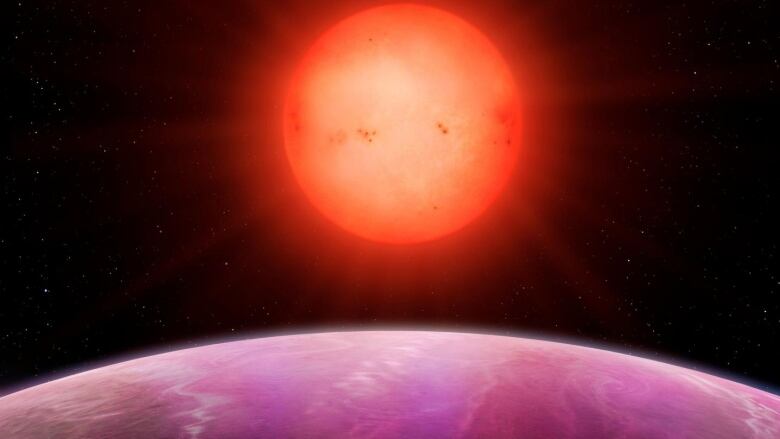Discovery of 'monster' planet surprises astronomers
'Hot Jupiter' orbits star with half the mass of our own sun

Astronomers thought they knew how planets formed, but a new discovery of a massive planet around an unlikely star is giving them pause.
A new planet, dubbedNGTS-1b, was discovered orbiting a small star 600 light years away.
The star is a red M-dwarf, the most common star in our universe. But until now, it wasn't believed that a gaseous planet of such a size, would ever exist orbiting this type of low-mass star.
"It was thought, before this discovery, that these stars are good at making small planetsbut didn't really produce large planets," Daniel Bayliss, of the University of Warwick's Astronomy and Astrophysics Groupin the U.K., told CBC News.
"And that's why it was a surprise when we found this one."
- Astronomers discover 'sunscreen' snow on distant exoplanet
- Newly discovered exoplanet best place to search for life
- Astronomers discover pitch-black planet orbiting distant star
NGTS-1bis what astronomers call a "hot Jupiter," a giant planet as large as or bigger than our most massive planet. ThoughNGTS-1bis about the same size as Jupiter, it has 20 per cent less mass and is just three per cent the distance between Earth and the sun. The planet orbits its star every 2.6 Earth days.
But the star itself has a mass of just half of our sun.
Though two other giant gas planets have been found around these types of stars (Kepler 45b and HATS-6b), NGTS-1b is the largest planet compared to the size of its host star ever found, which surprised the researchers.
Perhaps we've just been very lucky and found something that is very, very rare.- Daniel Bayliss, University of Warwick
The reason astronomers believed that a gas giant this large wasn't capable of forming around a low-mass star was due to the belief thatthere isn't enough material in a cloudof dust and debris that form star systems such as this one.
"Perhaps we've just been very lucky and found something that is very, very rare," said Bayliss, lead author of the paper which will be published in the journal Monthly Notices of the Royal Astronomical Society.
"But it's also possible that this is not so rare;we just have to think a little bit more about how these planets are forming, and perhaps they can form a lot more easily than we thought."
Finding this planet was no easy task. The telescopes lookfor tiny dips in the brightness of a star that might indicate a planet is orbiting it. But red dwarfs are dim.
"NGTS-1bwas difficult to find, despite being a monster of a planet, because its parent star is small and faint," Peter Wheatley, also from the University of Warwick, said in a statement.
Nature's surprises
Another interesting thing about the discovery is the age of the star. While the scientists are still working on nailing down its exact age, they believe it to be very old: somewhere between five and 10 billion years old. The age of the universe is roughly 13.8 billion years old.
Bayliss said that the next step is to find out how many more planets are in orbit around these low-mass stars. And they're hoping the new Next-Generation Transit survey facility in Chile, a collection of 12 telescopes that work together to search for exoplanets that made the discovery, will help.

Canadians are doing their part in the search as well.
A new instrument, the SpectroPolarimtre Infra-Rouge (SPIRou), developed in partnership with scientists at the Universite du Montreal, is set to be installed in the Canada-France-Hawaii Telescope in Hawaii by the end of the year.
Ray Jayawardhana, dean of science and a professor of physics and astronomy at York University in Toronto, who was not involved in the study, said the instrument will add to the discovery of the number of red M-dwarfstars found with planets, which will in turn provide astronomers with a better idea of the types of planets surrounding these stars.
Nature seems to be able to build planets readily, and it seems to be able to build them in surprising ways.- DanielBayliss, University of Warwick
"There's growing interest in understanding what kind of planets exist around a wide variety of stars, including red dwarfs," he told CBCNews.
The NGTS-1b discovery is promising, he said.
"Nature is producing a cornucopia of planetary systems, and there's a remarkable variety of them out there. So in that sense I'd say, while it's incredibly interesting, and perhaps a little bit surprising that there's a giant planet around an M-dwarf...they do exist, but they may be relatively rare."
With new technological advances, astronomers hope to add to the variety of worlds found, something that Baylisslooks forward to.
"Nature can always give us surprises, even when we think we know things quite well," he said.
"Even after 20 years of exoplanet discoveries, we can still get something that comes as a surprise. Nature seems to be able to build planets readily, and it seems to be able to build them in surprising ways."












_(720p).jpg)


 OFFICIAL HD MUSIC VIDEO.jpg)
.jpg)



























































































